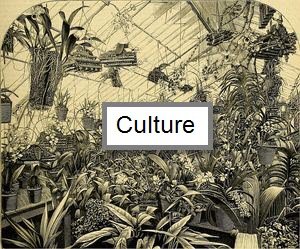The Influence of Temperature Requirements Among Orchids
THE MAJORITY OF ORCHIDS THAT hobbyists grow have direct or ancestral origins in tropical climates. While most regard any frost-free climate as tropical, there are many variations on the tropical climate theme, and orchids are found in nearly all of them.
In much of the tropics, a 10 to 15 F (-9 to -12 C) difference exists between the daytime high temperature and nighttime low temperature. This fluctuation is called diurnal variation and its range can vary with the seasons. It is important that hobby growers provide their orchids with this daily temperature swing, as it helps to promote strong, vigorous plants.
The best way to check diurnal variation is with the use of a maximum/minimum thermometer. These are available in a variety of price ranges. Some employ rather high-tech digital displays; others push tiny pins through traditional glass columns filled with mercury. Take your preference, but be sure to have at least one in your orchid-growing area. If you cultivate your collection in a large space, try to locate several maximum/minimum thermometers in various places. Check them regularly. This is one of the most important tools for orchid growers.
Also among the fundamentals of orchid culture is the notion that tropical orchids generally fall into one of three temperature groups, based on the temperature regimes of the particular tropical climate where each orchid species is native. The three groups are typically identified as warm-growing, intermediate-growing or cool-growing types. Interestingly, it is the nighttime low temperature, rather than the daytime high temperature, that tends to define each group. Note as well that we are referring to nighttime minimum temperatures during the coldest months.
COOL GROWING Cool growers are adapted to withstand cool season minimum temperatures as low as 50 to 55 F (10 to 13 C), and will not usually be harmed by 45 F (7 C) temperatures for short periods. Ideal warm season highs would be in the 60 to 70 F (15 to 21 C) range with tolerance for temperatures a bit warmer for brief spells. Think of these orchids as denizens of higher and mountainous elevations within the tropics, some of which come from locations that are frequently shrouded in clouds and mist.
INTERMEDIATE GROWING The group known as intermediate growers does best with winter minimum temp-eratures in the 55 to 60 F (10 to 15 C) range. Ideal summer high temperatures would be in the 65 to 75 F (18 to 24 C) span. Higher summer temperatures than these are usually well tolerated, particularly when accompanied with equally high humidity levels. Many of the orchids popular with hobby growers are included in this group.
WARM GROWING Orchids that are in the warm-growing group thrive when winter minimum temperatures seldom fall below 60 F (15 C). For best results, their high temperature range in summer should be in the 70 to 85 F (21 to 29 C) range. Most of them can easily tolerate temperatures up to 90 F (32 C) during warm weather, but prolonged exposure to higher temperatures should be avoided. Most warm-growing orchids demand high humidity levels, which can be challenging to maintain, particularly at higher temperatures. Imagine sitting under the shifting shade of a palm tree on a steamy tropical beach with a warm breeze coming off the water and you will have a good picture of what makes warm-growing orchids happy.
Of course, most orchids will survive temperatures well below or well above their preferred range for a short time, as many who have lost a greenhouse heater in winter or a greenhouse cooler in summer can attest. These temperature group guidelines are targets to help growers produce healthy plants that flower well.
There is variation among all plant species, orchids included, in their ability to thrive in a broad range of temperature regimes. Some species might thrive in cool, intermediate as well as warm conditions, while another species could tolerate just one tem-perature range. There can be variation in temperature response among individuals within a species as well.
A bit of research should help you establish any orchid species’ nativity and consequently help you understand the climate it comes from. In the case of hybrids, attempt to discover their species’ ancestry. This can be easily accomplished with any of several orchid databases currently available.
Orchid hybrids are often more temperature tolerant than their species ancestors, but may inherit a temperature preference from one parent over the other if large differences between them exist. It is difficult to list more than generalities regarding temperature preferences among orchids and variations often occur within a genus.
While it is frequently possible to maintain any particular orchid in less than ideal temperatures, you will find that plant vigor is improved and flowering enhanced when the maximum/minimum thermometer is carefully monitored and heeded. Also, those with larger growing spaces who employ several maximum/minimum thermometers may find microclimates within their growing space that enable them to cultivate plants spanning multiple temperature ranges.
Cool-Growing Orchids
Examples
Cymbidium
Masdevallia
Miltoniopsis
Odontoglossum
The compact size of Masdevallia veitchiana makes it a popular choice for growing under lights and on windowsills. Shown here is the clone ‘Highland Condor’, HCC/AOS. Grower: Highland Tropicals.
Intermediate-Growing Orchids
Examples
Cattleya
Encyclia
Oncidium
Paphiopedilum (many)
Zygopetalum
Cattleya gaskelliana var. coerulea ‘Katarina’s Blue’, HCC/AOS, conveys the beauty of orchids long cherished for their flamboyant flowers and fragrance. Grower: Peter Von Scholl.
Warm-Growing Orchids
Examples
Dendrobium (many)
Paphiopedilum (some)
Phalaenopsis
Vanda
Vandas and ascocendas offer myriad choices for warm-climate growers.
Shown here is Vanda tricolor var. suavis ‘Floradise’, AM/AOS. Grower: Joseph Francis.
